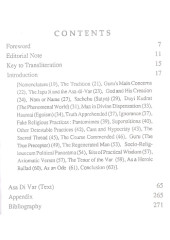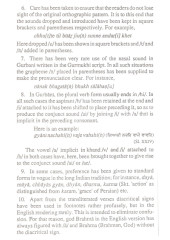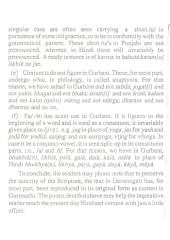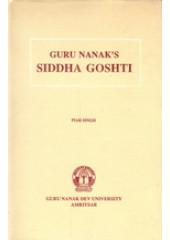Monday to Saturday - 10:00 Am to 9 PM
Now Enjoy Bulk Discounts on Books as Mentioned Below
These Discounts are in addition to the Discounts on Individual Books (Visible as Bulk Discount for Books in Cart)
Extra 10% Off If Books Purchased Exceeds Rs 3000 or 75 USD or 60 GBP or 60 Euro or 100 AUD or 100 CAD
Extra 15% Off If Books Purchased Exceeds Rs 6000 or 150 USD or 120 GBP or 120 Euro or 200 AUD or 200 CAD
Extra 20% Off If Books Purchased Exceeds Rs 15000 or 225 USD or 180 GBP or 180 Euro or 300 AUD or 300 CAD
Extra 25% Off If Books Purchased Exceeds Rs 30000 or 300 USD or 240 GBP or 240 Euro or 400 AUD or 400 CAD
Foreword To 'Guru Nanak's Asa di Vaar' By G.S.Randhawa
Probably with the sole exception of the Authorized Version of the Holy Bible, the scriptural texts of most major religions of the world are couched in archaic languages and vaguely familiar idiom. As such these do not readily lend themselves to easy comprehension by the average modem reader. Hence, very often people have to rely upon the professional interpreters to reveal to them the 'veiled' meaning of these texts. This being so, the average uninitiated reader does not have easy access even to the true essence of his own creed-nothing to say of knowing well enough even the basic tenets of other faiths.
On the other hand, for inter-faith understanding and dialogue, it is felt imperative that a faithful presentation of these texts be made available in a currently familiar language and idiom. That would enable people not only to get to know a little better the vitals of the faith they happen to have been born in, but also have a better appreciation of other faiths. Such a situation would facilitate more effective inter-faith dialogue. This has been one of the primary reasons prompting this exercise.
Also, as was indicated in the Foreword to its sister volume-Guru Nanak's Japuji this rendition, apart from catering to the needs of more discerning .of English readership, aims at meeting 'the needs of the second generation of emigrant Sikhs, who having stayed away from their native milieu a bit too long, have by now but only a nodding acquaintance with their ancestral language and tradition; and are perforce obliged to think and converse in English.' Besides, during my numerous visits abroad, I have come across very many elderly Sikh parents not only in the West, but also in countries like Philippines, Thailand etc. who for sentimental and other reasons desparately seek to provide to their younger generations faithful presentations of their scriptural texts in English. To provide for them too has been an added reason prompting this venture.
Poetry, critics say, is untranslatable. This is all the more so, when treatises of profound philosophical and mystic import of a certain language and milieu are sought to be rendered into another altogether alien language. In the earlier part of Asa Di Var, the task is, as in the case of the entire text of Japu ji, rendered quite challenging because of the terseness of the language. Scrupulous care has however been taken to ensure that the tenor of the original may be preserved as far as possible.
Now, Guru Nanak's primary object was to drive his message home to the common folk, who had for centuries been nursed and saturated in the traditional Indian idiom and symbols. He has therefore had to invariably draw heavily upon its past folk and legendary heritage. This precludes examination of his composition and individual verses too literally or in isolation. The attempt has hence been there to interpret Asa Di Var in close confirmity with the broader framework of his philosophy. A conscious effort has also been there to bring out the true spirit of his utterances and yet adhere as close to the principal text as possible. Particular care has also been taken to ensure that the true purport of involved expressions and subtle nuances of the verses be made as explicit as possibe in the process of the translation itself. Little has in this regard been left vague and amenable to vague and ambiguous interpretations. As such, some dilations have been felt to be unavoidable.
Though there is not the remotest presumption that this has been anything in the nature of a verse-to-verse rendering, yet in order to ensure a minimum of flow and readability some rhythm has been sought to be built in the lines and also a bit of rhyming, wherever it has been found possible. Ensuring a minimum of natural ease too has been attempted.
In the initial stages of this work, I received valuable assistance from my dear departed friend and colleague Dr. Piar Singh-Professor (retired) in the Department of Guru Nanak Studies at Guru Nanak Dev University, Amritsar. Apart from his profound scholarship, he was endowed with a rare critical acumen, an uncommon clarity of vision and an abiding love for Gurbani. I hope and pray that future years may throw up more and more scholars in his tradition and with his commitment.
My profound thanks are also due to my colleague Mr. J.S. Walia, Director, Press & Publications at the University. I fear, I taxed his patience a bit too far. Yet he was ever so pleasant and cooperative. I must place on record my unqualified appreciation of his professional competence and involvement.
About The Author Of 'Guru Nanak's Asa di Vaar'
Prof. G.S. Randhawa, ExVice-Chancellor, Guru Nanak Dev University, Amritsar is an academician of repute and an educational administrator of rare distinction. He has had a professional standing of nearly five decades; and has delivered extension lectures on a wide variety of subjects at some of the foremost universities of the world.
Though his basic discipline is English Literature, yet he has for long been a keen student of Sikh Studies and Comparative Theology. His firm commitment to Sikhism not with standing, he combines the same with a rare mix of catholicity of approach to other religious beliefs and to viewing of things with a well-grounded belief that 'Truth has never been nor can or shall ever be the sole monopoly of any single creed.'
| Books | |
| Author | G.S.Randhawa |
| Pages | 270 |
| Cover | Hardbound |
| PUB | GNDU |
| Language | English |
Guru Nanak's Asa di Vaar - Book By G.S.Randhawa
- Brand: Guru Nanak Dev University
- Product Code: GURE128
- Availability: In Stock
-
Rs.225.00
Related Products
Guru Nanak's Japu ji - Book By G.S.Randhawa
Foreword To 'Guru Nanak's Japu ji' By G.S.Randhawa The quincentenary of Guru Nanak, the fou..
Rs.200.00
Guru Nanak's Siddha Ghosti - Book By Piar Singh
Preface To 'Guru Nanak's Siddha Ghosti' By Piar Singh During the days of my association wit..
Rs.240.00
Scientific Vision in Sri Guru Granth Sahib and Interfaith Dialogue - Book By Hardev Singh Virk
Introduction To Book 'Scientific Vision in Sri Guru Granth Sahib and Interfaith Dialogue' By Hard..
Rs.225.00
Sikh History From Persian Sources - Book By J. S. Grewal and Irfan Habib
Summary Of 'Sikh History From Persian Sources' By J S Grewal And Irfan Habib This volum..
Rs.250.00
Guru Nanak Dev Ji - GN1083
Posters of Guru Nanak Dev Ji on Photographic Paper in Excellent Print Quality - We Supply Posters..
Rs.216.00
Tags: gurbani essence, gurbani explained, gurbani meanings english, gurbani message, gurbani steeks, gurbani teekas, sikh gurbani books english, sikh gurbani english translation guru, nanak, asa, vaar, g.s.randhawa











